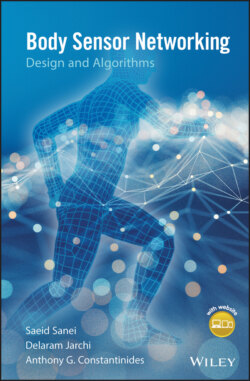Читать книгу Body Sensor Networking, Design and Algorithms - Saeid Sanei - Страница 2
Table of Contents
Оглавление1 Cover
2 Preface
3 About the Companion Website
4 1 Introduction 1.1 History of Wearable Technology 1.2 Introduction to BSN Technology 1.3 BSN Architecture 1.4 Layout of the Book References
5 2 Physical, Physiological, Biological, and Behavioural States of the Human Body 2.1 Introduction 2.2 Physical State of the Human Body 2.3 Physiological State of Human Body 2.4 Biological State of Human Body 2.5 Psychological and Behavioural State of the Human Body 2.6 Summary and Conclusions References
6 3 Physical, Physiological, and Biological Measurements 3.1 Introduction 3.2 Wearable Technology for Gait Monitoring 3.3 Physiological Sensors 3.4 Biological Sensors 3.5 Conclusions References
7 4 Ambulatory and Popular Sensor Measurements 4.1 Introduction 4.2 Heart Rate 4.3 Respiration 4.4 Blood Oxygen Saturation Level 4.5 Blood Pressure 4.6 Blood Glucose 4.7 Body Temperature 4.8 Commercial Sensors 4.9 Conclusions References
8 5 Polysomnography and Sleep Analysis 5.1 Introduction 5.2 Polysomnography 5.3 Sleep Stage Classification 5.4 Monitoring Movements and Body Position During Sleep 5.5 Conclusions References
9 6 Noninvasive, Intrusive, and Nonintrusive Measurements 6.1 Introduction 6.2 Noninvasive Monitoring 6.3 Contactless Monitoring 6.4 Implantable Sensor Systems 6.5 Conclusions References
10 7 Single and Multiple Sensor Networking for Gait Analysis 7.1 Introduction 7.2 Gait Events and Parameters 7.3 Standard Gait Measurement Systems 7.4 Wearable Sensors for Gait Analysis 7.5 Gait Analysis Algorithms Based on Accelerometer/Gyroscope 7.6 Conclusions References
11 8 Popular Health Monitoring Systems 8.1 Introduction 8.2 Technology for Data Acquisition 8.3 Physiological Health Monitoring Technologies 8.4 Conclusions References
12 9 Machine Learning for Sensor Networks 9.1 Introduction 9.2 Clustering Approaches 9.3 Classification Algorithms 9.4 Common Spatial Patterns 9.5 Applications of Machine Learning in BSNs and WSNs 9.6 Conclusions References
13 10 Signal Processing for Sensor Networks 10.1 Introduction 10.2 Signal Processing Problems for Sensor Networks 10.3 Fundamental Concepts in Signal Processing 10.4 Mathematical Data Models 10.5 Transform Domain Signal Analysis 10.6 Time-frequency Domain Transforms 10.7 Adaptive Filtering 10.8 Cooperative Adaptive Filtering 10.9 Multichannel Signal Processing 10.10 Signal Processing Platforms for BANs 10.11 Conclusions References
14 11 Communication Systems for Body Area Networks 11.1 Introduction 11.2 Short-range Communication Systems 11.3 Limitations, Interferences, Noise, and Artefacts 11.4 Channel Modelling 11.5 BAN-WSN Communications 11.6 Routing in WBAN 11.7 BAN-building Network Integration 11.8 Cooperative BANs 11.9 BAN Security 11.10 Conclusions References
15 12 Energy Harvesting Enabled Body Sensor Networks 12.1 Introduction 12.2 Energy Conservation 12.3 Network Capacity 12.4 Energy Harvesting 12.5 Challenges in Energy Harvesting 12.6 Types of Energy Harvesting 12.7 Topology Control 12.8 Typical Energy Harvesters for BSNs 12.9 Predicting Availability of Energy 12.10 Reliability of Energy Storage 12.11 Conclusions References
16 13 Quality of Service, Security, and Privacy for Wearable Sensor Data 13.1 Introduction 13.2 Threats to a BAN 13.3 Data Security and Most Common Encryption Methods 13.4 Quality of Service (QoS) 13.5 System Security 13.6 Privacy 13.7 Conclusions References
17 14 Existing Projects and Platforms 14.1 Introduction 14.2 Existing Wearable Devices 14.3 BAN Programming Framework 14.4 Commercial Sensor Node Hardware Platforms 14.5 BAN Software Platforms 14.6 Popular BAN Application Domains 14.7 Conclusions References
18 15 Conclusions and Suggestions for Future Research 15.1 Summary 15.2 Future Directions in BSN Research 15.3 Conclusions References
19 Index
20 End User License Agreement
